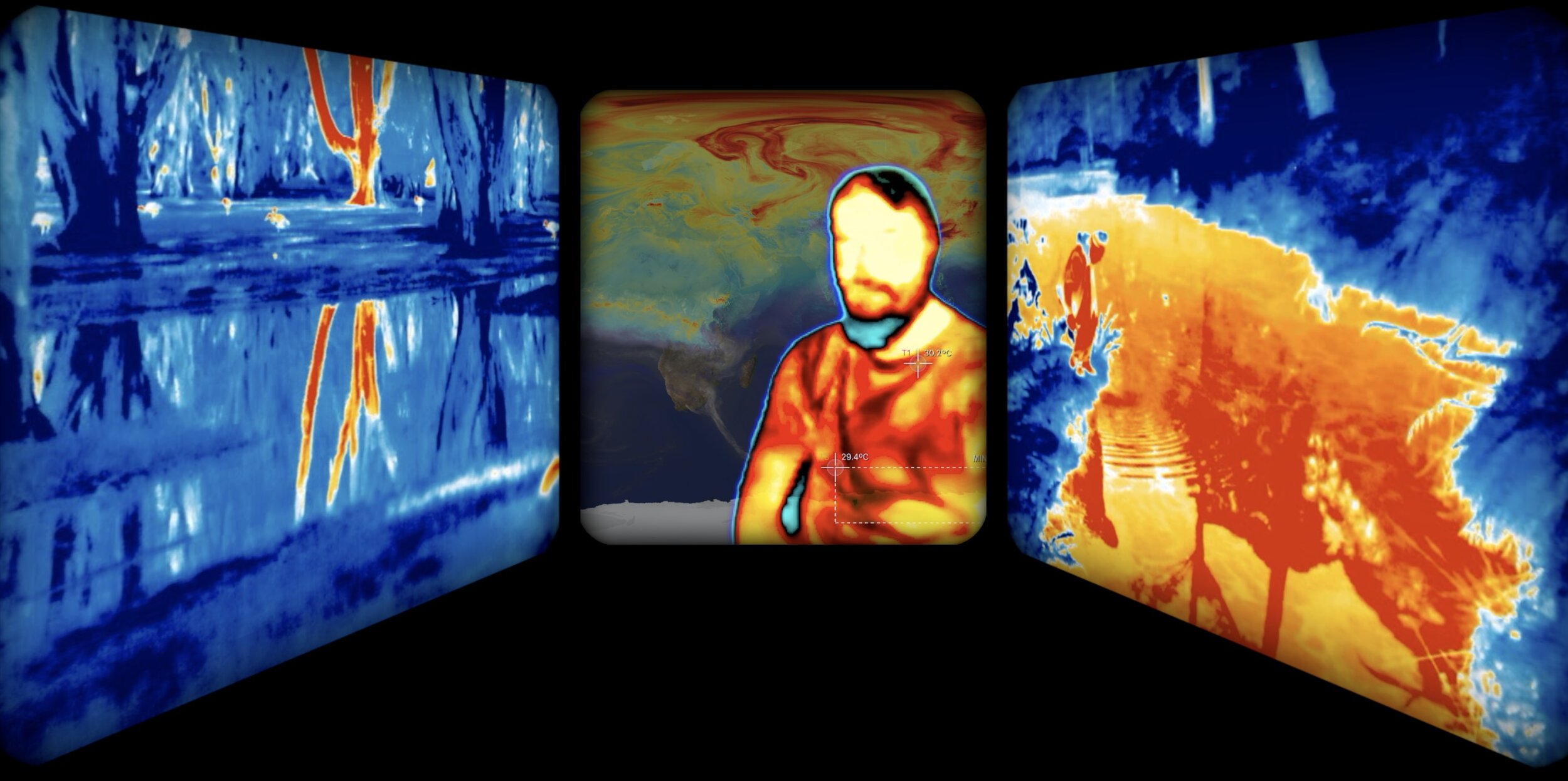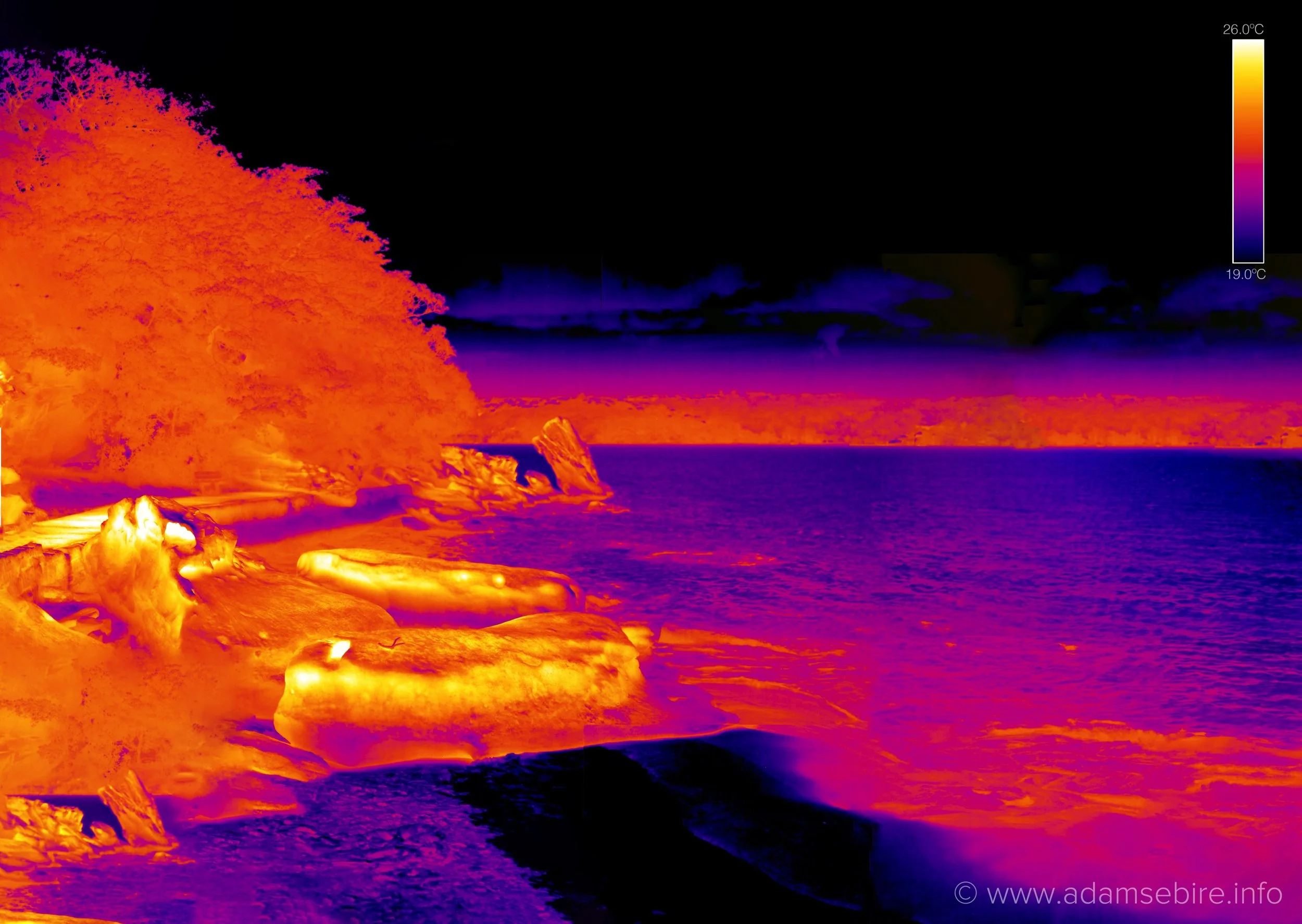Feeling the Heat
Thermographic video triptych for exhibition spaces. Tech specs:
3x screens or projectors: wings 4:3 aspect ratio; centre HD 16:9 (vertical 9:16 or 4:3 centre also available.)
3x media players (Lūpa recommended), stereo audio. Dimensions variable (previewed above as split-screen).
Duration: 15’00". Subtitles file available for translation to any language.
Video (2018-2019) by Adam Sébire (PhD student, UNSW Faculty of Art & Design), music by Martin Franke.
Screenings: Glasgow Science Centre’s ‘Greenhouse’ for Curious About: Our Planet August-December 2021, to coincide with COP26 Glasgow. Exhibited in triple-screen form 28 December 2022 till 31 May 2023 alongside selected stills at the Wuhan Art Museum (Qintai Museum, seen in cover image for video above) for the Wuhan Biennial. May 2023, at Umbrella Arts in Concord, MA (USA) as part of the Points of Return group show; at the National Natural History Museum of China (Beijing) in conjunction with WWF and Art & Science Research Center (China) 26 September to 22 October, 2023; finalist in the CMCC Climate Change Communication Award, November 2023; exhibiting 3-30 April 2025 at Klimasozial, Linz, Austria.
How do climate scientists, working on the front line of a problem that's invisible to most of us, respond to it as human beings, as citizens of this planet?
Feeling the Heat is presented as a visually spectacular triptych featuring rare thermographic imagery of natural and built environments and, in between, climate scientists interviewed with their own thermal imaging equipment.
The work explores a new approach to climate change communication, which frees normally objective professionals to talk to us in a subjective, even passionate manner. How do the disturbing implications of climate change affect the scientists tasked with studying it — on a personal level? Despite the existential dimensions of their research they’re usually expected to eschew emotion, adhering to detached, dispassionate modes of the scientific method lest it taint their empirical assemblage of evidence. But even when they do so, they may find themselves targets of those who would rather not hear their rationalised conclusions. As a result of their research they’re “feeling the heat” in more ways than one.
The artwork forms part of Adam Sébire's PhD research into aesthetic visual representations of climate change. This collaboration with climate scientists uses a thermographic imager usually employed to measure leaf temperatures during heatwaves. Using it for infrared thermal interviews ‘cloaks’ the scientists visually — as heat data — allowing them to speak anonymously, candidly and personally, whilst engaging a wider audience.
There is increasing literature documenting scientists’ despondency ('climate-related depression’). Clive Hamilton describes them as “modern-day Cassandras” whose warnings go unheeded. Their research often requires them to “think the unthinkable” as they venture to the far end of probability curves. Their recommendations follow the Precautionary Principle — hoping for the best while preparing for the worst. Yet the science of climate change is all too frequently eclipsed by its short-termist politics and the temptation of some is to shoot the messenger. Scientists expressing an emotional response (to a problem which threatens to make the planet unliveable for many of its species) therefore remains taboo, and climate science communication is largely confined to probabilities, tables, graphs and data.
Scientists, for their part, often assume that given enough of the right information people will modify their behaviour accordingly. However climate change is proving that a response takes more than knowledge of the scientific consensus. Climate psychology suggests an emotional connection is necessary. For a problem with such major implications, purely dispassionate presentation of evidence may not help its societal acceptance. And so this work offers viewers a different point of entry.
Exhibition view at 2022 Wuhan Biennale, Qintai Art Museum, Wuhan City, Hubei Province, China, 28 Dec 2022 to 31 May 2023. (Photos courtesy Qintai Art Museum).
ARTIST STATEMENT
I’m interested in the everyday sensory (im)perceptibility of global warming to those of us living typically hermetic existences in the West. Largely insulated from the vicissitudes of weather it’s easier for us to ignore looming climatic upheavals with little or no direct experience of them to confront.
Effects of the invisible problem of climate change are furthermore displaced from their causes both in time and in space, creating cognitive dissonances in our ways of thinking about the problem. Its difficult spatio-temporal dimensions lead philosopher Timothy Morton to conceptualise global warming as a vast ‘hyperobject’ demanding new aesthetic approaches which straddle visible/invisible, here/there, self/other, and past/present/future.
And so I use thermography (infra-red heat photography*) to explore the imperceptibility of anthropogenic warming to our senses. As part of my search for an aesthetics for the Anthropocene I struggle with these extremely cumbersome and low-resolution, yet fascinating scientific instruments. My models and I must shoot at night: the camera is uninterested in visible light, and in the lower temperatures after sunset I discovered that human bodies ‘illuminate’ the surrounding environment with their radiant heat, a metonymic visualisation for how (some) members of our species are rapidly warming the planet.
This photographic series (Lambda prints on Endura Metallic paper) is part of an ongoing (2015— ) interdisciplinary science/art project. The artworks are created with a high-resolution thermal imaging camera loaned from scientists at the Climate Change Cluster (C3) and School of Life Sciences at the University of Technology, Sydney — to whom I’m enormously grateful for their advice, trust and generosity.
* Is it indeed photography? In Wikipedia’s definition, yes: “Photography is the science, art, application and practice of creating durable images by recording light or other electromagnetic radiation, either electronically by means of an image sensor, or chemically by means of a light-sensitive material such as photographic film…”
Above: Narcissus by the Reflecting Pool (Infrared Image 00662-5) (2015)
About the work: This thermographic (infrared) image was recorded one clear midwinter's night in Blackheath. It uses a thermal imaging camera loaned from UTS climate scientists. I was looking for new visual representations of global warming beyond the usual glaciers, smokestacks, floods and droughts; something that evoked its anthropogenic, human origins; but also from a non-human perspective. In my experiments I discovered thermography could show our species warming the environment — both literally and metaphorically. In this scene the pond had retained enough heat from the day to reflect the atmosphere glowing an eery warm orange. I posed as Narcissus, one of many Greek mythological figures whose stories warn humans against hubris.
Above: Blue Mountains, Australia, (Infrared thermographic panorama #IR001251-62) (2015)
60cm x 180cm, Edition of 6. Price - AUD$2,800.00 : contact 80:20 Artist Agency, Sydney (Director: Bill Seeto)
Scientists have proposed that we've left the Holocene epoch: the 12,000 years of relative climatic stability that enabled human civilisation. Impressions of anthropogenic global warming are recorded here with a thermographic imager during one of the abnormally warm winters here that characterised the early decades of the Anthropocene.
(Right: enlargement of the image reveals the raw heat data values of each pixel;
thermal imagers can export either an image or a data spreadsheet; or as here, both.)
exhibition: in the heat of the moment
Thermographic art by Adam Sébire
An interdisciplinary art/science exploration of the sensory (im)perceptibility of anthropogenic global warming.
The exhibition comprises thermographic stills & video art of bodies in Australian bush landscapes, created using a high-resolution thermal imager loaned from the UTS Climate Change Cluster (C3) as part of a Culture at Work residency.
Thursday 4 June — Monday 8 June 2015
Exhibition open 12:00-17:00 daily incl. Monday public holiday
Opening drinks Thursday 4th June 18:00-20:00
(short artist’s talk and introduction by Prof. Bruce Milthorpe, Dean of Science at University of Technology Sydney at 19:00)
venue: Accelerator Gallery, Culture at Work
6 Scott Street, Pyrmont, Sydney, Australia (light rail: John Street Square)
With thanks to:
UTS Faculty of Science
Dr. Andrea Leigh
Prof. Bruce Milthorpe
Dr. Lisa Roberts
Marea Martlew
Culture at Work
Sherryl Ryan
and
• Anney Bounpraseuth
• Nina Gallo • Josie Howlett
• Michelle Demos • Sue Theron
About the works:
Thermography aims to record and visualise the invisible: infrared heat data.
The United Nations’ Intergovernmental Panel on Climate Change (IPCC) has gathered evidence that our planet’s surface temperature has already risen by an average of 0.89ºC over the period 1901–2012 — and sea levels by 19cm from 1901-2010* — yet these figures rarely make themselves apparent in our daily lives.
For global warming is what philosopher Timothy Morton terms a hyperobject — "an entity that is so vast and so long lasting that we humans only see pieces of it at a time". Furthermore, its effects develop in spatial and temporal dislocation from their causes, making them difficult to represent in a society which emphasises “seeing is believing”.
Until it's too late, that is.
in the heat of the moment thermographically images bodies in Australian bush environments to explore — on an aesthetic level — anthropogenic (human-made) global warming. It uses a high-resolution thermal imaging camera generously loaned from Dr. Andrea Leigh in the UTS Climate Change Cluster (C3), where it's used to analyse leaf temperatures in Australia's arid zones. (Imagers of higher resolution than this are restricted technology due to their military applications.) The imager records hundreds of thousands of points of heat data in infrared wavelengths before its data visualisation in colour spectra apprehensible to the human eye.
Over many months I learnt to use the device, experimenting with its data aesthetically through cinematic techniques such as depth of field, mise-en-scène, camera movement, and slow motion. By adjusting the device's parameters in ways probably unintended by its engineers, the resultant thermograms take on quasi-Fauvist qualities.
In these videos and stills nature is brought to the fore whilst the defocussed human figures punctuate the night scenes' backgrounds with their radiant heat, illuminating and silhouetting the foliage. In the video works they leave behind heat prints on their surrounding environment. In this way thermal imagery perhaps offers us a non-human perspective on the Anthropocene.
— Adam Sébire, June 2015.
*REFERENCE
Working Group I Contribution to the IPCC Fifth Assessment Report, Intergovernmental Panel on Climate Change. "Climate Change 2013: The Physical Science Basis." Stockholm, Sweden, 2013. 6, Section B4.





The Testo 890-2 imager used, plus exhibition shots from Culture at Work's Accelerator Gallery, Sydney, June 2015.
You can read an interview with Adam about his artwork around global warming and the Anthropocene on Climate in Conversation (July 2016) or download the PDF, right:
THERMOGRAPHIC STOCK VIDEOS / THERMAL IMAGER PHOTOGRAPHS
Many photos are for sale as stock photos on Stocksy (use code A_OF_AU20); thermal imaging stock video clips are on Pond5 (link incl. referral discount). Or contact me to buy directly. Some more recent field experiments with the infrared imager are below:
dance performance: melt (in the heat of the moment)
Filmmaker/Artist: Adam Sébire
Choreographer: Robyn Seiboth
Dancers: Sally Biermann, Lisa Roberts, Robyn Seiboth
Using the same techniques as described above, live projections of thermographic dance were created for the BEAMS Festival, Chippendale Creative Precinct, on the evening of Saturday 19 September 2015.
The dancers were rear-projected realtime from within a disused shop onto its glass coated with Greek yoghurt — to form an organic screen for the thousands of Festival-goers outside. The live dance was interspersed with thermographic images of rural and urban environments (see video below) while the performers took breaks. The choreography explored how the heat energy of our bodies shapes the world around us: from touch in interpersonal relationships right up to a global level, where our actions warm our planet.
(Behind the scenes documentation courtesy Lisa Roberts on YouTube.)
Vimeo password for the above: thermals
Some thermographic video tests, plus stills from the triptych:
















































